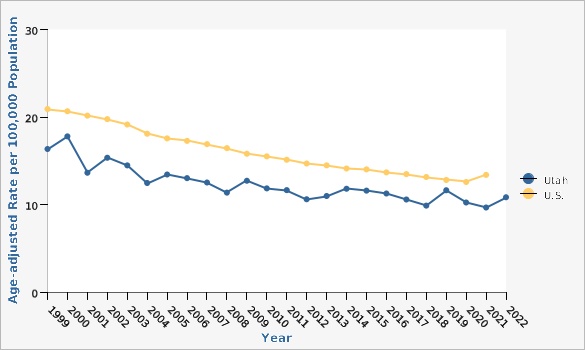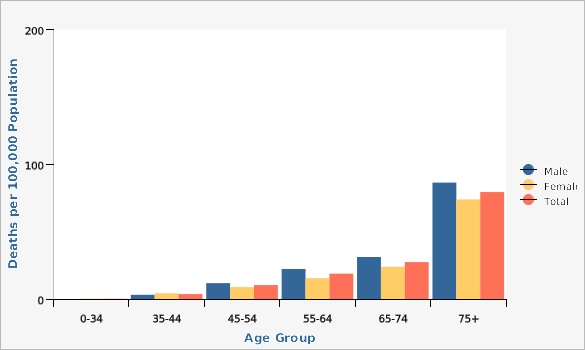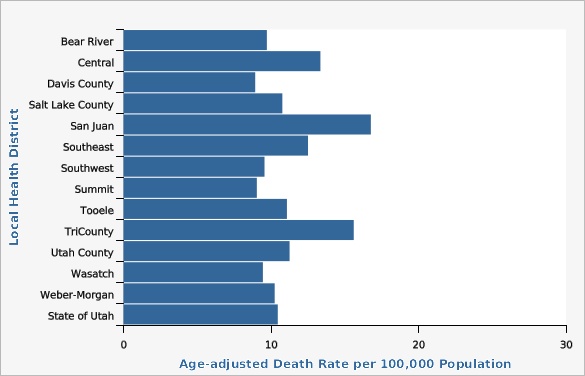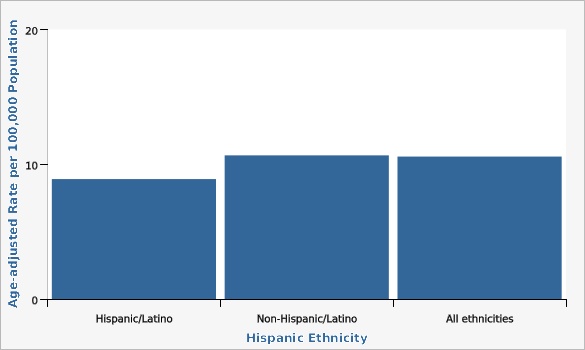Complete PHOM Indicator Profile Report of Colorectal Cancer Deaths
Definition
The rate of death from cancer of the colon or rectum (ICD-10: C18-C21) per 100,000 persons.Numerator
The number of deaths due to colorectal cancer for a given time period (ICD-10: C18-C21).Denominator
The population in Utah or the U.S. for a given time period.Why Is This Important?
Colorectal cancer is one of the leading causes of cancer-related deaths in Utah and across the U.S. Deaths from colorectal cancer can be substantially reduced when precancerous polyps are detected early and removed. When colorectal cancer is diagnosed early, 90% of patients survive at least five years^1^. Several scientific organizations recommend that routine screening for colorectal cancer begin at age 50 for adults at average risk. Persons at high risk may need to begin screening at a younger age. Routine screening can include either an annual fecal occult blood test (FOBT), a flexible sigmoidoscopy every five years, a colonoscopy every 10 years, or a double-contrast barium enema every 5 to 10 years. Studies have shown that FOBT testing, when performed every 1 to 2 years in people aged 50 to 80 years, can help reduce the number of deaths due to colorectal cancer by 15 to 33 percent^2,3^. The National Cancer Institute advises each individual to discuss risk factors and screening options with their health care provider. Medicare and many insurance plans now help to pay for colorectal cancer screening.[[br]] [[br]] ---- 1. American Cancer Society, Colorectal Cancer Facts & Figures 2017-2019 Accesed at: [http://www.cancer.org/acs/groups/content/documents/document/acspc-042280.pdf].[[br]] 2. Burch JA, Soares-Weiser K, St John DJ, et al. Diagnostic accuracy of fecal occult blood tests used in screening for colorectal cancer: A systematic review. ''Journal of Medical Screening'' 2007; 14(3):132-137.[[br]] 3. Ouyang DL, Chen JJ, Getzenberg RH, Schoen RE. Noninvasive testing for colorectal cancer: A review. ''American Journal of Gastroenterology'' 2005; 100(6):1393-1403.Healthy People Objective: Reduce the colorectal cancer death rate
U.S. Target: 14.5 deaths per 100,000 populationHow Are We Doing?
The Utah colorectal cancer mortality rate has decreased significantly, from 17.8 deaths per 100,000 persons in the year 2000 to 10.3 deaths per 100,000 persons in 2020. The Utah colorectal cancer mortality rate has also remained slightly lower than the U.S. mortality rate over time. The latest available data estimates from 2018 show the U.S. colorectal cancer death rate to be 13.5 deaths per 100,000 persons, compared to 9.9 deaths per 100,000 persons in Utah. Rates of colorectal cancer deaths in Utah vary by age, sex, geography, ethnicity, and race. Looking at data from combined years 2018-2020, rates of colorectal cancer death significantly increase with age for both males and females. Males have higher rates of colorectal cancer deaths than females across all age groups. From 2016 to 2020 combined data, TriCounty Local Health District (LHD) had the highest colorectal cancer mortality rate of 15.7 deaths per 100,000 persons, while Summit County LHD had the lowest rate with 7.3 deaths per 100,000 persons. Other geographical distribution of colorectal cancer deaths can also be viewed in more detail at the Utah Small Area level (see additional data views). For combined years 2018-2020, there was no significant difference in colorectal cancer death rates between those of Hispanic (8.3 deaths per 100,000 persons) and non-Hispanic ethnicity (10.5 deaths per 100,000 persons). When looking at colorectal cancer mortality rates by race for the time period 2016-2020, those who identified racially as Pacific Islander/Native Hawaiian had significantly higher colorectal cancer death rates (19.2 deaths per 100,000 persons) than all other races combined (10.4 deaths per 100,000 persons).How Do We Compare With the U.S.?
The Utah colorectal cancer mortality rate has remained slightly lower than the U.S. mortality rate over time. The latest available data estimates from 2018 show the U.S. colorectal cancer death rate to be 13.5 deaths per 100,000 persons, compared to 9.9 deaths per 100,000 persons in Utah.What Is Being Done?
Screening for colorectal cancer has recently been identified by the Centers for Disease Control and Prevention (CDC) as a priority public health issue. The the Utah Cancer Control Program (UCCP) monitors the use of colorectal cancer screening tests by Utahns through the statewide Behavioral Risk Factor Surveillance System (BRFSS), which is conducted annually.Available Services
Insurance coverage of colorectal cancer screening tests is required by the Affordable Care Act (ACA). However, the ACA doesn't apply to health plans that were in place before it was passed (so-called grandfathered plans). You can find out your insurance plan's grandfathered status by contacting your health insurance company or your employer's human resources department. If your plan started on or after September 23, 2010, it is required to cover regular colonoscopies and other colorectal cancer screening tests. If a plan started before September 23, 2010, it may still have coverage requirements from state laws, which vary, and other federal laws.More Information
Utah Cancer Control Program: [http://www.cancerutah.org][[br]] Utah Cancer Action Network: [http://www.ucan.cc][[br]] American Cancer Society: [http://www.cancer.org][[br]] National Cancer Institute: [http://www.cancer.gov][[br]] Huntsman Cancer Institute: [http://www.huntsmancancer.org][[br]] Centers for Disease Control and Prevention: [http://www.cdc.gov][[br]] American Society of Clinical Oncology: [http://www.asco.org]Health Program Information
The Utah Comprehensive Cancer Control program (CCC) and its affiliated coalition, the Utah Cancer Action Network (UCAN), work together with state and local partners to reduce the burden of cancer in Utah. Their mission is to lower cancer incidence, morbidity, and mortality in Utah through collaborative efforts directed toward cancer prevention and control. As a result, they support community-based strategies around food security, healthy neighborhoods, access to health care, and financial toxicity in order to prevent cancer; detect cancer early; and improve the lives of cancer survivors, caregivers, and their families.Graphical Data Views
| Utah vs. U.S. | Year | Age-adjusted Rate per 100,000 Population | Lower Limit | Upper Limit | ||
|---|---|---|---|---|---|---|
Record Count: 42 | ||||||
| Utah | 1999 | 16.4 | 14.4 | 18.6 | ||
| Utah | 2000 | 17.8 | 15.8 | 20.0 | ||
| Utah | 2001 | 13.6 | 11.9 | 15.6 | ||
| Utah | 2002 | 15.4 | 13.5 | 17.4 | ||
| Utah | 2003 | 14.5 | 12.7 | 16.4 | ||
| Utah | 2004 | 12.5 | 10.8 | 14.3 | ||
| Utah | 2005 | 13.4 | 11.8 | 15.3 | ||
| Utah | 2006 | 13.0 | 11.4 | 14.8 | ||
| Utah | 2007 | 12.5 | 11.0 | 14.2 | ||
| Utah | 2008 | 11.4 | 9.9 | 13.0 | ||
| Utah | 2009 | 12.7 | 11.2 | 14.4 | ||
| Utah | 2010 | 11.9 | 10.4 | 13.4 | ||
| Utah | 2011 | 11.6 | 10.2 | 13.2 | ||
| Utah | 2012 | 10.6 | 9.3 | 12.0 | ||
| Utah | 2013 | 11.0 | 9.7 | 12.4 | ||
| Utah | 2014 | 11.8 | 10.4 | 13.3 | ||
| Utah | 2015 | 11.6 | 10.3 | 13.1 | ||
| Utah | 2016 | 11.3 | 10.0 | 12.7 | ||
| Utah | 2017 | 10.6 | 9.4 | 12.0 | ||
| Utah | 2018 | 9.9 | 8.7 | 11.1 | ||
| Utah | 2019 | 11.6 | 10.4 | 13.0 | ||
| Utah | 2020 | 10.3 | 9.2 | 11.6 | ||
| U.S. | 1999 | 20.9 | 20.8 | 21.1 | ||
| U.S. | 2000 | 20.8 | 20.6 | 20.9 | ||
| U.S. | 2001 | 20.2 | 20.0 | 20.4 | ||
| U.S. | 2002 | 19.8 | 19.6 | 20.0 | ||
| U.S. | 2003 | 19.2 | 19.0 | 19.4 | ||
| U.S. | 2004 | 18.2 | 18.0 | 18.3 | ||
| U.S. | 2005 | 17.7 | 17.5 | 17.8 | ||
| U.S. | 2006 | 17.4 | 17.3 | 17.6 | ||
| U.S. | 2007 | 17.0 | 16.9 | 17.2 | ||
| U.S. | 2008 | 16.6 | 16.5 | 16.8 | ||
| U.S. | 2009 | 16.0 | 15.9 | 16.1 | ||
| U.S. | 2010 | 15.8 | 15.7 | 15.9 | ||
| U.S. | 2011 | 15.3 | 15.2 | 15.4 | ||
| U.S. | 2012 | 14.9 | 14.8 | 15.0 | ||
| U.S. | 2013 | 14.6 | 14.5 | 14.7 | ||
| U.S. | 2014 | 14.4 | 14.2 | 14.5 | ||
| U.S. | 2015 | 14.3 | 14.2 | 14.4 | ||
| U.S. | 2016 | 14.0 | 13.9 | 14.1 | ||
| U.S. | 2017 | 13.8 | 13.7 | 13.9 | ||
| U.S. | 2018 | 13.4 | 13.3 | 13.6 | ||
Data Notes
ICD-10 codes used to define colorectal cancer: C18-C21. Age-adjusted to U.S. 2000 standard population.Data Sources
- Utah Death Certificate Database, Office of Vital Records and Statistics, Utah Department of Health
- Population Estimates: National Center for Health Statistics (NCHS) through a collaborative agreement with the U.S. Census Bureau, IBIS Version 2020
- U.S. Cancer Statistics: WONDER Online Database. United States Department of Health and Human Services, Centers for Disease Control and Prevention and National Cancer Institute. Accessed at [http://wonder.cdc.gov/cancer.html]
- National Vital Statistics System, National Center for Health Statistics, U.S. Centers for Disease Control and Prevention
| Males vs. Females | Age Group | Deaths per 100,000 Population | Lower Limit | Upper Limit | Note | |
|---|---|---|---|---|---|---|
Record Count: 18 | ||||||
| Male | 0-34 | 0.3 | 0.1 | 0.5 | * | |
| Male | 35-44 | 3.0 | 1.8 | 4.6 | ||
| Male | 45-54 | 9.6 | 7.1 | 12.7 | ||
| Male | 55-64 | 24.0 | 19.7 | 29.0 | ||
| Male | 65-74 | 39.6 | 32.9 | 47.2 | ||
| Male | 75+ | 83.6 | 71.3 | 97.5 | ||
| Female | 0-34 | 0.3 | 0.1 | 0.6 | * | |
| Female | 35-44 | 2.8 | 1.6 | 4.4 | ||
| Female | 45-54 | 8.4 | 6.0 | 11.4 | ||
| Female | 55-64 | 16.2 | 12.8 | 20.4 | ||
| Female | 65-74 | 26.9 | 21.7 | 33.0 | ||
| Female | 75+ | 79.3 | 68.5 | 91.3 | ||
| Total | 0-34 | 0.3 | 0.1 | 0.4 | ||
| Total | 35-44 | 2.9 | 2.0 | 3.9 | ||
| Total | 45-54 | 9.0 | 7.2 | 11.1 | ||
| Total | 55-64 | 20.1 | 17.3 | 23.2 | ||
| Total | 65-74 | 33.0 | 28.7 | 37.6 | ||
| Total | 75+ | 81.2 | 73.0 | 90.1 | ||
Data Notes
Codes used to define colorectal cancer: ICD-10 C18-21. [[br]] *Use caution in interpreting, the estimate has a relative standard error greater than 30% and does not meet UDOH standards for reliability. For more information, please go to http://ibis.health.utah.gov/pdf/resource/DataSuppression.pdf. **The estimate has been suppressed because 1) the relative standard error is greater than 50% or 2) the observed number of events is very small and not appropriate for publication.Data Sources
- Utah Death Certificate Database, Office of Vital Records and Statistics, Utah Department of Health
- Population Estimates: National Center for Health Statistics (NCHS) through a collaborative agreement with the U.S. Census Bureau, IBIS Version 2020
| Local Health District | Age-adjusted Death Rate per 100,000 Population | Lower Limit | Upper Limit | Note | ||
|---|---|---|---|---|---|---|
Record Count: 14 | ||||||
| Bear River | 9.4 | 7.3 | 11.9 | |||
| Central | 10.4 | 7.6 | 14.0 | |||
| Davis County | 10.0 | 8.4 | 11.9 | |||
| Salt Lake County | 11.0 | 10.1 | 12.0 | |||
| San Juan | 13.4 | 6.6 | 24.3 | * | ||
| Southeast | 12.1 | 8.0 | 17.4 | |||
| Southwest | 9.5 | 8.0 | 11.2 | |||
| Summit | 7.3 | 3.8 | 12.8 | |||
| Tooele | 15.5 | 10.9 | 21.4 | |||
| TriCounty | 15.7 | 11.2 | 21.5 | |||
| Utah County | 11.3 | 9.8 | 13.0 | |||
| Wasatch | 10.3 | 5.6 | 17.5 | |||
| Weber-Morgan | 10.4 | 8.6 | 12.4 | |||
| State of Utah | 10.7 | 10.2 | 11.3 | |||
Data Notes
Codes used to define colorectal cancer: ICD-10 C18-21.[[br]] Age-adjusted to U.S. 2000 standard population.[[br]] ^ ^*Use caution in interpreting, the estimate has a relative standard error greater than 30% and does not meet UDOH standards for reliability. For more information, please go to [http://ibis.health.utah.gov/pdf/resource/DataSuppression.pdf].[[br]] Note: Prior to 2015 San Juan County was part of the Southeast Local Health District. In 2015 the San Juan County Local Health District was formed. Data reported are for all years using the current boundaries.Data Sources
- Utah Death Certificate Database, Office of Vital Records and Statistics, Utah Department of Health
- Population Estimates: National Center for Health Statistics (NCHS) through a collaborative agreement with the U.S. Census Bureau, IBIS Version 2020
| Utah Small Areas | Age-adjusted Rate per 100,000 Population | Lower Limit | Upper Limit | Note | ||
|---|---|---|---|---|---|---|
Record Count: 103 | ||||||
| Brigham City | 14.6 | 8.8 | 22.8 | |||
| Box Elder Co (Other) V2 | 7.3 | 1.9 | 19.0 | * | ||
| Tremonton | 5.6 | 1.5 | 14.4 | * | ||
| Logan V2 | 9.4 | 5.6 | 14.8 | |||
| North Logan | 5.9 | 1.9 | 14.0 | * | ||
| Cache (Other)/Rich (All) V2 | 15.3 | 8.6 | 25.0 | |||
| Hyrum | ** | ** | ||||
| Smithfield | ** | ** | ||||
| Ben Lomond | 12.5 | 8.6 | 17.5 | |||
| Weber County (East) | 11.7 | 7.3 | 17.9 | |||
| Morgan County | ** | ** | ||||
| Ogden (Downtown) | 8.5 | 4.4 | 14.8 | |||
| South Ogden | 7.1 | 3.9 | 11.8 | |||
| Roy/Hooper | 10.2 | 6.2 | 15.8 | |||
| Riverdale | 11.8 | 6.9 | 18.6 | |||
| Clearfield Area/Hooper | 15.3 | 10.3 | 22.0 | |||
| Layton/South Weber | 8.6 | 5.6 | 12.6 | |||
| Kaysville/Fruit Heights | 5.5 | 2.4 | 10.6 | * | ||
| Syracuse | 12.0 | 5.1 | 24.1 | * | ||
| Centerville | 11.7 | 5.6 | 21.6 | * | ||
| Farmington | 13.6 | 7.1 | 23.7 | |||
| North Salt Lake | 5.1 | 1.3 | 13.8 | * | ||
| Woods Cross/West Bountiful | 20.2 | 8.0 | 42.0 | * | ||
| Bountiful | 9.7 | 6.4 | 14.1 | |||
| SLC (Rose Park) | 10.7 | 6.0 | 17.6 | |||
| SLC (Avenues) | 6.2 | 2.6 | 12.6 | * | ||
| SLC (Foothill/East Bench) | 6.6 | 2.7 | 13.4 | * | ||
| Magna | 20.8 | 12.1 | 33.5 | |||
| SLC (Glendale) V2 | 15.3 | 7.8 | 27.1 | |||
| West Valley (Center) | 14.6 | 9.5 | 21.4 | |||
| West Valley (West) V2 | 14.7 | 7.5 | 26.0 | |||
| West Valley (East) V2 | 16.8 | 11.4 | 24.0 | |||
| SLC (Downtown) V2 | 7.3 | 3.7 | 12.9 | |||
| SLC (Southeast Liberty) | 10.9 | 5.2 | 20.2 | * | ||
| South Salt Lake | 16.2 | 9.8 | 25.2 | |||
| SLC (Sugar House) | 6.6 | 3.5 | 11.4 | |||
| Millcreek (South) | 2.2 | 0.6 | 5.6 | * | ||
| Millcreek (East) | 9.5 | 5.2 | 16.1 | |||
| Holladay V2 | 12.8 | 8.0 | 19.4 | |||
| Cottonwood | 9.9 | 6.5 | 14.4 | |||
| Kearns V2 | 12.8 | 7.1 | 21.2 | |||
| Taylorsville (E)/Murray (W) | 12.3 | 7.7 | 18.6 | |||
| Taylorsville (West) | 16.1 | 10.3 | 24.1 | |||
| Murray | 9.2 | 5.3 | 14.9 | |||
| Midvale | 13.5 | 8.1 | 21.1 | |||
| West Jordan (Northeast) V2 | 10.8 | 5.4 | 19.1 | |||
| West Jordan (Southeast) | 13.3 | 7.3 | 22.0 | |||
| West Jordan (W)/Copperton | 6.2 | 2.8 | 11.7 | * | ||
| South Jordan V2 | 7.8 | 4.4 | 12.7 | |||
| Daybreak | 15.1 | 6.5 | 29.9 | * | ||
| Sandy (West) | 12.4 | 7.2 | 20.0 | |||
| Sandy (Center) V2 | 10.2 | 5.4 | 17.7 | |||
| Sandy (Northeast) | 14.1 | 8.0 | 23.1 | |||
| Sandy (Southeast) | 8.9 | 4.7 | 15.1 | |||
| Draper | 12.6 | 7.8 | 19.3 | |||
| Riverton/Bluffdale | 13.1 | 7.6 | 21.2 | |||
| Herriman | 14.7 | 7.2 | 26.8 | |||
| Tooele County (Other) | 13.9 | 6.1 | 27.0 | * | ||
| Tooele Valley | 15.8 | 10.4 | 22.9 | |||
| Eagle Mountain/Cedar Valley | 21.0 | 7.8 | 45.5 | * | ||
| Lehi | 8.7 | 4.6 | 14.8 | |||
| Saratoga Springs | 11.6 | 3.9 | 26.8 | * | ||
| American Fork | 10.7 | 6.2 | 17.0 | |||
| Alpine | 13.1 | 4.7 | 29.1 | * | ||
| Pleasant Grove/Lindon | 10.0 | 6.2 | 15.4 | |||
| Orem (North) | 18.4 | 11.7 | 27.6 | |||
| Orem (West) | 8.8 | 4.2 | 16.3 | * | ||
| Orem (East) | 13.0 | 7.2 | 21.7 | |||
| Provo/BYU | 5.8 | 2.7 | 10.9 | * | ||
| Provo (West City Center) | 15.4 | 8.3 | 26.1 | |||
| Provo (East City Center) | 13.8 | 5.5 | 28.5 | * | ||
| Salem City | ** | ** | ||||
| Spanish Fork | 15.7 | 9.2 | 25.0 | |||
| Springville | 10.1 | 5.2 | 17.7 | |||
| Mapleton | 14.2 | 4.6 | 33.5 | * | ||
| Utah County (South) V2 | 24.0 | 10.2 | 47.7 | * | ||
| Payson | 14.3 | 7.5 | 24.7 | |||
| Park City | 2.0 | 0.5 | 5.2 | * | ||
| Summit County (East) | 17.7 | 7.8 | 34.4 | * | ||
| Wasatch County | 10.8 | 5.9 | 18.2 | |||
| Daggett and Uintah County | 18.0 | 11.8 | 26.2 | |||
| Duchesne County | 13.5 | 7.0 | 23.4 | |||
| Nephi/Mona | 22.2 | 10.0 | 42.7 | * | ||
| Delta/Fillmore | ** | ** | ||||
| Sanpete Valley | 7.8 | 3.3 | 15.5 | * | ||
| Central (Other) | 12.7 | 7.3 | 20.6 | |||
| Richfield/Monroe/Salina | 9.6 | 4.4 | 18.3 | * | ||
| Carbon County | 12.7 | 7.0 | 21.1 | |||
| Emery County | 14.9 | 6.2 | 30.0 | * | ||
| Grand County | 11.0 | 4.3 | 23.1 | * | ||
| Blanding/Monticello | 19.6 | 8.2 | 39.3 | * | ||
| San Juan County (Other) | ** | ** | ||||
| St. George | 10.6 | 8.0 | 13.7 | |||
| Washington Co (Other) V2 | 9.1 | 3.4 | 19.4 | * | ||
| Washington City | 7.3 | 3.6 | 13.2 | * | ||
| Hurricane/La Verkin | 12.6 | 7.2 | 20.4 | |||
| Ivins/Santa Clara | 9.6 | 4.7 | 17.3 | * | ||
| Cedar City | 14.0 | 9.1 | 20.6 | |||
| Southwest LHD (Other) | 7.1 | 3.6 | 12.7 | |||
| State of Utah | 10.7 | 10.2 | 11.3 | |||
Data Notes
Age-adjusted to the U.S. 2000 standard population. *Use caution in interpreting, the estimate has a relative standard error greater than 30% and does not meet UDOH standards for reliability. For more information, please go to [http://ibis.health.utah.gov/pdf/resource/DataSuppression.pdf] **The estimate has been suppressed because 1) the relative standard error is greater than 50% or 2) the observed number of events is very small and not appropriate for publication. A description of the Utah Small Areas may be found on IBIS at the following URL: [https://ibis.health.utah.gov/resource/Guidelines.html].Data Source
Utah Death Certificate Database, Office of Vital Records and Statistics, Utah Department of Health| Hispanic Ethnicity | Age-adjusted Rate per 100,000 Population | Lower Limit | Upper Limit | |||
|---|---|---|---|---|---|---|
Record Count: 3 | ||||||
| Hispanic | 9.2 | 7.4 | 11.3 | |||
| Non-Hispanic | 10.5 | 9.9 | 11.1 | |||
| All Utahns | 10.4 | 9.9 | 10.9 | |||
Data Notes
Codes used to define colorectal cancer: ICD-10 C18-21.[[br]] Age-adjusted to U.S. 2000 standard population. Used 3 age adjustment groups (0-44, 45-64, and 65+)Data Sources
- Utah Death Certificate Database, Office of Vital Records and Statistics, Utah Department of Health
- Population Estimates by Age, Sex, Race, and Hispanic Origin for Counties in Utah, U.S. Bureau of the Census, IBIS Version 2020
| Race | Age-adjusted Rate per 100,000 Population | Lower Limit | Upper Limit | Note | ||
|---|---|---|---|---|---|---|
Record Count: 6 | ||||||
| American Indian/Native Alaskan | 8.2 | 4.2 | 14.4 | |||
| Asian | 11.8 | 8.2 | 16.5 | |||
| Black | 10.8 | 5.0 | 20.2 | * | ||
| Pacific Islander | 19.2 | 11.5 | 30.0 | |||
| White | 10.2 | 9.7 | 10.8 | |||
| All Races | 10.5 | 10.0 | 11.0 | |||
Data Notes
Codes used to define colorectal cancer: ICD-10 C18-21.[[br]] Rates are age-adjusted to the 2000 U.S. standard population using 3 age groups (0-44, 45-64, and 65+). *Use caution in interpreting; the estimate has a coefficient of variation > 30% and is therefore deemed unreliable by Utah Department of Health standards. Consider aggregating years to decrease the relative standard error and improve the reliability of the estimate.Data Sources
- Utah Death Certificate Database, Office of Vital Records and Statistics, Utah Department of Health
- Population Estimates by Age, Sex, Race, and Hispanic Origin for Counties in Utah, U.S. Bureau of the Census, IBIS Version 2020
Page Content Updated On 04/14/2022,
Published on 04/14/2022






